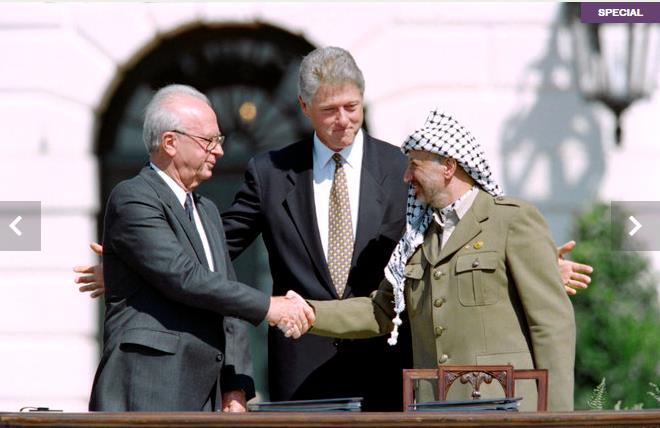
AMICHAI, Palestinian Territories: A panoramic view of mountains and neighboring Palestinian villages before him, Avichai Boaran thinks back on the Oslo accords first signed off on 25 years ago and happily declares them dead.
“Oslo is buried deep in its grave,” says the 45-year-old resident of Amichai, a new Israeli settlement in the occupied West Bank, referring to the first of the two accords signed on September 13, 1993.
“And Israelis are jumping on the earth to pack it down hard.”
Twenty-five years after the first Oslo accord offered the prospect of Israeli-Palestinian peace, Israel is governed by what is seen as its most right-wing government ever, Jewish settler numbers have soared and an end to the conflict looks remote.
When Israeli prime minister Yitzhak Rabin and Palestinian leader Yasser Arafat sealed the first Oslo agreement with a handshake on the White House lawn, there were 110,066 settlers in the West Bank and another 6,234 in the Gaza Strip, according to Israeli settlement watchdog Peace Now.
Today the Gaza settlers are gone, pulled out in a 2005 move by prime minister Ariel Sharon that fiercely divided Israeli opinion.
But there are some 600,000 settlers living among nearly three million Palestinians in the West Bank and Israeli-annexed east Jerusalem.
Key members of Israeli Prime Minister Benjamin Netanyahu’s current coalition openly oppose a Palestinian state and have harshly criticized the Oslo accords.
In June last year, work started on Amichai in the northern West Bank, the first new government-sanctioned Jewish settlement since 1991, though existing settlements and rogue outposts have expanded greatly during that time.
Amichai is being built for about 40 families that were evicted from Amona, a community built without Israeli permits that was demolished in February 2017.
One of them is Boaran, a former Amona resident who fought against its closure then became a leader of the campaign to rehouse those evicted.
In March he and his family moved into their new home, a modest prefabricated building but with modern amenities such as a dishwasher and air conditioning.
He told AFP that the Oslo agreement galvanized Israeli public opinion against a Palestinian state on land that many Jews consider their biblical birthright.
“The aim was complete withdrawal (by Jewish settlers) and to set up in the heart of the land of Israel, the heart of the Jewish homeland, an additional state...an additional Arab state,” he said.
“We are not prepared to accept a society which will turn its weapons and its national aspirations against us. We are ruling out strategically the vision of a Palestinian state.”
Netanyahu entered office as prime minister for the first time in 1996 after elections in which he was buoyed — at least in part — by a groundswell of anti-Oslo opinion among voters.
Rabin had in the meantime been assassinated in November 1995 by a Jewish extremist opposed to the accords.
Envisaged by the Oslo plan, although not stated explicitly, was a sovereign Palestinian state living peacefully alongside Israel.
Terje Roed-Larsen, a Norwegian academic who in 1992 headed an Oslo institute for social research, became a prime mover of a covert plan to bring together Israelis and officials of the Palestine Liberation Organization (PLO).
At the time, the PLO was listed by Israel as a terror organization.
Roed-Larsen spoke with Yossi Beilin, who would later become Israeli deputy foreign minister, and eventually explored setting up back-channel talks with Arafat.
“We started talks with Faisal Husseini, who was the Palestinian leader in Jerusalem,” Roed-Larsen said by phone from New York, where he now heads the International Peace Institute think-tank.
“What I realized through those talks was that without the PLO and Arafat it was impossible to reach any kind of agreement because it would have been blocked by the PLO.”
It was agreed that the Norwegians should be the brokers at the sessions, which took place largely in Oslo, lending the agreement its name.
Although the Oslo process eventually ground to a halt, Roed-Larsen says it was not a failure.
“Still the two-state solution is a viable idea,” he said.
He added that without the signs of a thaw between Israel and the Palestinians, Jordan could not have signed a 1994 peace treaty with the Jewish state.
While the international community still sees two states as the preferred outcome, Israelis are evenly divided and few see any end to the conflict with the Palestinians in the near term.
An August poll by the Israel Democracy Institute and Tel Aviv University showed 47 percent of respondents in favor of two states and 46 percent against.
It said that 86 percent saw the chances of a peace breakthrough in the coming 12 months as “low” or “very low.”












